BUSINESS
The UTV Race Heats Up
How Consumer Thirst for Excitement and Escape Is Boosting the Market
By Mike Imlay
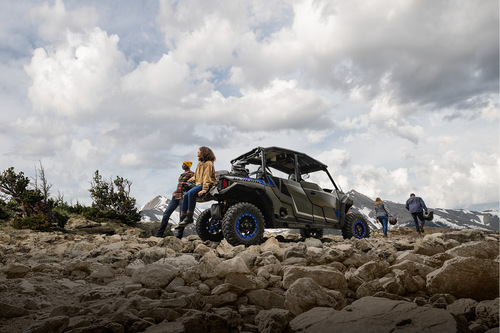
pandemic lockdowns, sales in the side-by-side category reached new
heights in 2020. Hot with consumers, UTV vehicles like the Polaris
General are riper than ever for a broad range of aftermarket
enhancements. Courtesy: Polaris
The powersports UTV market seems to get better and better each year, not just in terms of the vehicles themselves but also in terms of the increasing number of consumers flocking to the side-by-side lifestyle. It’s a phenomenon that not even a pandemic can stop.
Since the Yamaha Rhino first popularized UTV recreation in 2004, numerous OEMs have flooded the market with a diversity of side-by-side models aimed at youth, families, outdoor aficionados and hardcore racers. According to Motorcycle & Powersports News Editor-at-Large Brendan Baker, today’s UTV space has become fiercely competitive, with most OEMs churning out quality, capable products. Current favorites include Polaris and its RZR models, Yamaha with its Wolverine, Honda and its Talon lineup, and Can-Am, best known for its Mavericks. Each manufacturer also offers additional lines tailored for a variety of levels and uses. (For the utility-minded sportsman, even John Deere has entered the fray with its stalwart Gator models.) Among all those brands, however, Polaris is currently the dominant player.
“Overall, the difference is that Polaris has been doing it longer,” Baker explained. “They have the name and more models out there. They’re the Harley of the side-by-side market, but you’ve also got a lot of second-tier-level OEMs coming out with decent products—newer stuff at a lower price point, more value brands. People want a UTV, but they don’t necessarily want to take out a second mortgage to get it.”
2020 in Hindsight
As it did in so many sectors, COVID-19 shook the 2020 UTV market. Several of its largest OEMs temporarily shut production facilities, and dealers contended with lockdowns early last year. But like the vehicles themselves, the side-by-side segment proved remarkably resilient.
“I think everybody was pleasantly surprised and happy that the industry had a record year in 2020, which you wouldn’t have guessed going into March,” Baker said. “Somewhere in April, things started to turn around because people got the stimulus money. There were still people working and logging in from home, but they were also like, ‘Hey, what can I do during a lockdown?’ And that’s when they decided, ‘I’m buying a dirt bike, motorcycle or UTV,’ and things really took off.
“I almost think [the national shutdown] helped. It cleared out a lot of the inventory the dealers had. A lot of used and pre-owned stuff got sold off as well. In the end, demand was up and they were able to move product.
“We don’t have exact UTV numbers, but Polaris was up 29% in their off-road segment for the fourth quarter of 2020. That’s a pretty good jump that’s representative of the industry. UTVs have always been strong. They’re about half of the powersports market—they’re that powerful. If anything, more riders came in last year, and I don’t see that slowing down.”
According to industry experts, surging interest in UTV motorsports has also primed consumer enthusiasm for the vehicles—and that enthusiasm continued unabated despite the pandemic and the resulting cancellation of many 2020 events. When King of the Hammers (KOH) announced that its 15th annual off-road race would take place in February 2021 with enhanced COVID-19 safety precautions, all eyes were on Johnson Valley, California. Could KOH pull it off? Would the spectators show? The answers were yes and emphatically yes. Attendance topped 10,000.
That bodes well for other motorsports events, which have become the latest proving grounds for UTV manufacturers and specialty-equipment suppliers, observed Jim Ryan, marketing director for SCORE International. As the old saying goes, competition betters the breed.
“UTVs have been part of SCORE [desert racing] for many years now,” Ryan said. “In fact, we have six classes, and they all represent a developmental area for the OEMs. UTVs are our factory wars now. It’s not Ford, Chevy, Dodge. It’s not even Honda, Kawasaki, Yamaha, Husqvarna or KTM. It’s Polaris and Can-Am. Arctic Cat was in there for a while, and now there are also Robby Gordon’s new Speed UTV lines. That’s where the factory riders are, and that’s where the factory efforts are.”
Ryan added that UTV participation has grown to now represent about 20% of the SCORE field.
“We have unlimited classes, we have stock classes, turbo classes, non-aspirated classes, open, unlimited classes, which involve everything in the UTV category,” he said. “The ability of UTVs to finish even the most brutal races is quite impressive, and there’s an entire industry built up around the aftermarket. There are probably 40, 50, 60 hardcore manufacturers attached to that area in terms of performance applications and general or appearance modifications. Every category from automotive suspension to wheels, tires, safety equipment—all that transfers straight over into UTVs nowadays.”
Ryan further noted that SCORE’s social-media numbers continue to indicate a high level of fan engagement for the UTV classes and that the old “race on Sunday, buy on Monday” axiom is very real with UTV consumers.
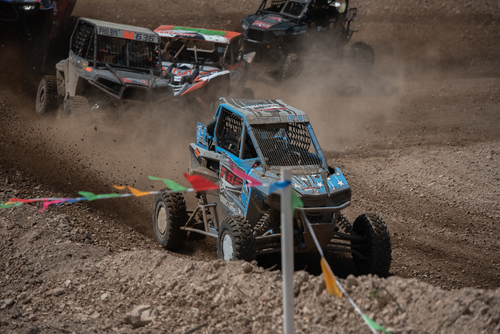
the low cost of entry is drawing an increasing number of competitors
into UTV motorsports. BOOSTane recently announced a partnership
with Driven Racing to create fuel additives and lubrication solutions
for the growing side-by-side market. Photo courtesy: BOOSTane
The Race for Market Share
That thirst for motorsports-inspired performance means there’s plenty of opportunity for aftermarket businesses considering a jump into the marketplace, according to BOOSTane founder and engineer Ian Lehn.
“The water is not only warm, it’s scorching hot right now,” he said. “As a lot of people are now aware, BOOSTane and Driven Racing have come together in a collaborative partnership for engineering and new market development, and the first crack that we’re going to be taking is the powersports market.”
He added that today’s UTV drivers expect extreme levels of performance and efficiency from their vehicles—demands that he believes can’t be achieved without addressing fuel and lubrication.
“We’re going to be offering a fuel additive as a race-fuel alternative for higher-performance applications,” Lehn said. “Our engineering teams have been working together on a few different products still in development, including an application-specific engine oil for both wet-clutch and non-wet-clutch applications for Polaris, Can-Am, Honda and Yamaha vehicles. The last piece will be an oil specific to the front and rear diffs.”
A racer himself, Lehn believes that the low cost of entry is drawing more drivers into UTV motorsports, along with enthusiast consumers energized by what they see at the competitions.
“The opportunity is there for a family of four to purchase one vehicle and keep up with the maintenance versus buying four separate ATVs or four separate motorcycles,” he said. “With one UTV you’ve got a vehicle to go out and have fun in the outdoors all year round. The vehicles are designed for subzero temperatures and speeding through the desert and everything from racing to hunting, overlanding and camping. They have a lot of versatility. It doesn’t matter what your business model is—there’s a part of these vehicles and their market segment that [any company] could probably influence.”
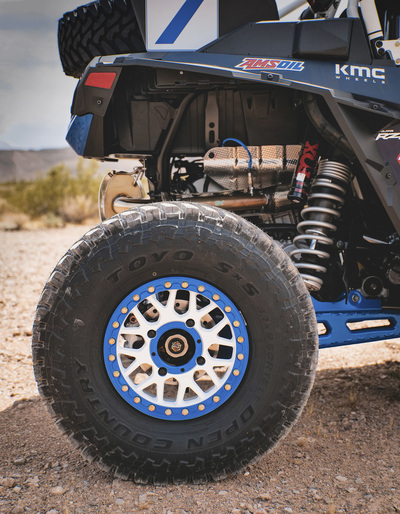
are often among the first upgrades UTV owners will
splurge on. Toyo drew on its success with its Open
Country M/T-R off-roading racing tire to introduce an
Open Country SxS 32x9.50R15 tire specifically aimed at
the UTV market.
Hypertech General Manager John Lambert said that his company added a thus-far successful UTV product line just over two years ago.
“We wanted to introduce our Max Energy Spectrum Power Programmer for the market, along with a supporting product line of popular high-quality accessories,” he said. “Our tuning product was an obvious introduction of Hypertech to the market.”
In a short time, the company’s many offerings have grown to include not only the CARB-approved power programmer for Polaris but also suspension limiting straps, a pistol-grip shifter, and such utility items as front-door storage bags, a UTV recovery kit, a tire repair kit, and other performance and safety items.
“We’re the first company to obtain an executive order (EO) for aftermarket tuning for the Polaris RZR,” Lambert said. “We also obtained an EO for our Xtreme Blow-Off Valve, which is also an industry first.
“The accessory product line came to fruition because of discussions we had with employees who are also off-roaders with UTVs. We want to serve these enthusiasts with a full product line that shows off our expertise in product design by offering numerous products that are all top-notch.”
According to Lambert, the latter point is essential to standing out in the crowd of businesses rushing into the market.
“It seems that there are a lot of people and companies trying to make products for UTV consumers,” he observed. “That means a lot of online sellers racing to the bottom of the pricing ladder. You can see that many products sacrifice quality to position themselves competitively at the lowest price. We decided to buck that trend and make products that showcase quality and performance.”
Crossing over to the UTV realm has been an equally natural and profitable progression for lighting suppliers like Oracle Lighting.
“A big focus of what we’ve been doing lately has been powersports and adapting existing products to work in those applications and also developing new products specifically for powersports,” said Oracle Director of Development Justin Hartenstein. “A big part of our customer base is off-road-type vehicles, whether for the truck market or the Jeep and SUV market, so a lot of our products in those categories lend themselves to powersports use as well.”
Hartenstein said that adapting lighting and other aftermarket products to UTVs doesn’t necessarily require a lot of engineering. Today’s larger side-by-sides aren’t much smaller than a Jeep or a compact SUV, so many of Oracle’s universal products easily exchange across platforms. (The company also makes vehicle-specific applications.) Moreover, UTVs share many features in common with their larger vehicle counterparts.
“The lighting systems on them are really similar to automotive lighting systems,” Hartenstein said. “They have daytime running lights, high beams, low beams and fault lights in some applications, so we approach [product development] the same way we would for OE-replacement parts for something like a modern SUV.”
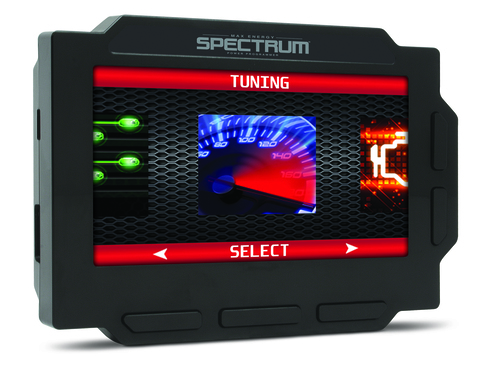
Hypertech recently introduced its Max Energy Spectrum Power
Programmer for Polaris tuning. The company’s offerings also now
include suspension limit straps, a pistol-grip shifter and various other
performance and safety items.
Modification-Hungry Consumers
When it comes to the customer base, Hartenstein said that UTV enthusiasts are especially prone to specialty upgrades, with many consumers opting to purchase less-expensive utility or base models from UTV dealers so they can spend more on customizing them for desert running, trail riding, mud bogging, or simply hunting, fishing or ranch chores.
“Just because they’re utility vehicles doesn’t mean people don’t like to modify them,” he said. “For example, there are plenty of people modifying the Polaris Ranger just because it’s a lower price of entry. They might spend a little less on the purchase price but put money into aftermarket parts—wheels, tires, lights and things like that to make it stand out.”
In fact, as with fullsize trucks and Jeeps, wheels and tires are among the first and most popular upgrades UTV purchasers undertake.
Cameron Parsons, product engineer and field analyst for the competition and specialty tires division of Toyo Tire USA Corp., said that the company introduced its 32x9.50R15 Open Country SxS in 2019. It’s a popular size used on more aggressive side-by-side vehicles and in off-road racing.
“We’ve had a special interest in this segment for years, largely due to our recent race wins and season championships in both desert and short-course racing,” he said. “As the popularity of side-by vehicles grew among both enthusiasts and racers, it only made sense for Toyo to draw inspiration from our Baja-race-winning Open Country M/T-R and build a similar tire geared toward side-by-side applications.”
Parsons characterized the UTV tire market as “very competitive” for tiremakers.
“Side-by-sides are quickly changing and becoming more capable with each new model,” he said. “For that reason, we approached this segment from a motorsports perspective, where tires are put to the most strenuous tests in terms of performance and durability.
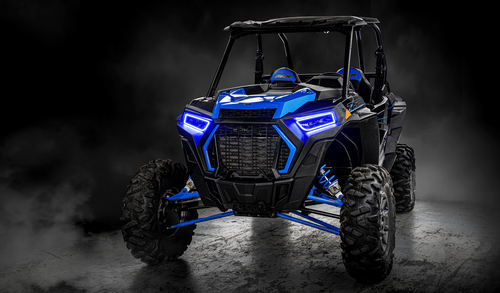
natural opportunity for ORACLE Lighting. Because UTVs share so
many traits with fullsize off-road vehicles, many of the company’s
products adapt easily across platforms, although ORACLE also
develops vehicle-specific applications.
“A majority of side-by-side owners are interested in exploration, speed or both. We’ve also found that many of these owners enjoy modifying and upgrading their vehicles to enhance their capabilities further. They don’t take their side-by-sides for easy drives on flat roads. They drive through rough and complicated terrains, slide through fast corners, and they occasionally seek out jumps when they can find them.”
That translates to seemingly limitless opportunities for the aftermarket. In addition to wheels and tires, engine and tuning enhancements and lighting, frequent consumer buys include exhaust and suspension components, sound systems and mobile electronics, winches and recovery gear, and helmets, harnesses and related safety products. Replacement windshields, doors and roof options as well as cargo-management solutions and tools for the trail are also big sellers.
In the end, Baker said, the UTV market is all about motorsports-inspired performance and a freedom-loving lifestyle.
“There’s so much possibility with these vehicles, and people are going to want more of the already fair amount of aftermarket parts available,” he asserted. “And the more, the merrier, in my opinion. The cream will rise to the top, and a lot of SEMA companies already know how to build good product. It’s just a matter of gearing it up for UTVs.”
 Explore the Opportunities
Explore the Opportunities
SEMA Market Research estimates that more than 80% of UTV owners will purchase accessories for their vehicle and lifestyle. Further, research indicates that the average accessorizer will spend in excess of $1,700 outfitting their side-by-side. To explore this and additional research relating to this market, go to www.sema.org/market-research where you can download the “SEMA Powersports: UTV Accessorization Report” along with other market reports to assist your aftermarket business.






